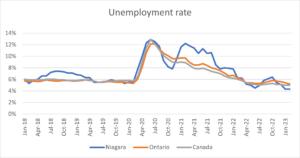In this edition:
- Niagara unemployment rate holds steady, still lowest on record
- Niagara Region resolves lawsuit with Caslin, Tamming, and D’Amboise
- Ontario to make Technical Education credits mandatory for highschoolers
- Applications for 2023-24 Inclusive Community Grants open
- Volatile winter weather affecting icewine production in Ontario, producers say
Niagara unemployment rate holds steady, still lowest on record
 Niagara’s unemployment rate was 4.3% in February, remaining at the record low observed in January as the size of the labour force crept up from 231,000 to 231,100. Niagara remains significantly below both the national and provincial rates.
Niagara’s unemployment rate was 4.3% in February, remaining at the record low observed in January as the size of the labour force crept up from 231,000 to 231,100. Niagara remains significantly below both the national and provincial rates.
Canadian employment held steady in February (+22,000; +0.1%), and the unemployment rate was unchanged at 5.0%.
Employment grew in health care and social assistance (+15,000; +0.6%), public administration (+10,000; +0.9%), and utilities (+7,500; +5.0%). At the same time, fewer people worked in business, building and other support services (-11,000; -1.5%).
The number of employees grew in the private sector (+39,000; +0.3%), while there was little change in public sector employment and in the number of self-employed.
Click here to access Statistics Canada’s interactive Labour Force Survey app.
Click here for more visualizations of Niagara’s labour force data.
Niagara Region resolves lawsuit with Caslin, Tamming, and D’Amboise
Niagara Region has announced that it reached a settlement with former regional chair Alan Caslin, and his staff Jason Tamming and Robert D’Amboise, regarding the compromised hiring of the Region’s Chief Administrative Officer (CAO) in 2016.
The resolved lawsuit against Caslin, Tamming and D’Amboise claimed those individuals breached their duty of good faith and duty of confidentiality to the Region in their involvement of hiring former CAO Carmen D’Angelo. The Niagara Region maintains its position that the actions of Caslin, D’Amboise and Tamming were egregious and occurred in precisely the manner that was described in the Ontario Ombudsman’s “Inside Job” investigation report.
Ontario to make Technical Education credits mandatory for highschoolers
Starting with students entering Grade 9 in September 2024, all Ontario students will now be required to earn a Grade 9 or 10 Technological Education credit as part of their Ontario Secondary School Diploma, the Government of Ontario announced today.
This new learning graduation requirement will expose Ontario’s students to at least one Technological Education course that the Province hopes could guide them to a future career in the highly skilled workforce, including the skilled trades.
The Government stated that there are over 100,000 unfilled skilled trades jobs in the province.
Applications for 2023-24 Inclusive Community Grants open
Applications for the 2023-24 round of Inclusive Community Grants opened today. These grants provide municipalities, non-profit organizations, and Indigenous communities with up to $60,000 for local projects that will help older residents and people with disabilities participate in community life.
This year, Ontario is prioritizing projects focused on improving opportunities for community engagement and those that support older adults to age and live at home with access to care.
Volatile winter weather affecting icewine production in Ontario, producers say
It’s been a tough season for icewine in Ontario.
Unpredictable and fluctuating winter weather, combined with a reduced vine crop due to a debilitating cold snap last year, has meant a smaller yield this season. And some producers have opted out of making the dessert wine altogether.
“It looks like there wasn’t a lot of icewine made this year,” Aaron Dobbin, president of the Wine Growers of Ontario, said in an interview.
“The volatility — that’s what we’re seeing right now as the biggest challenge with climate change.”
Focus on International Trade
Net foreign asset position climbs after three quarters of decreases
Canada’s net foreign asset position, the difference between its international financial assets and international liabilities, increased by $223.9 billion to $839.7 billion at the end of the fourth quarter, the first increase after three consecutive quarterly declines.
Overall, changes in market prices led to a $203.4 billion increase in Canada’s net foreign asset position. Over the fourth quarter, the US (+7.1%) and European (+14.3%) stock markets rose, and the Canadian stock market gained 5.1%. At the end of the fourth quarter, 65.1% of Canada’s international assets and 42.4% of its international liabilities were held in the form of equities.
Through the Daily Updates, the GNCC aims to deliver important business news in a timely manner. We disseminate all news and information we feel will be important to businesses. Inclusion in the Daily Update is not an endorsement by the GNCC.



